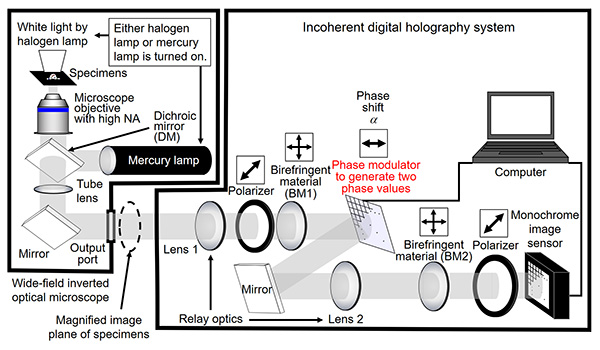A research team from the National Institute of Information and Communications Technology (NICT), Tohoku University, Toin University of Yokohama, and the Japan Science and Technology Agency (JST) have developed a scanless high-speed holographic fluorescence microscopy system with a submicron resolution of 3D space.
Their achievements were published in the journal Optics Letters on January 29, 2021.
Digital holography is used to record 3D information without any scanning optics. An image sensor records a hologram from which a computer reconstructs a 3D image of a specimen using a mathematical procedure. This image processing works in tandem with the optical sensors to produce a more complete and deeper view of an object.

Creating a digital hologram of fluorescent objects is notoriously difficult because fluorescent is incoherent and makes rendering holograms impossible without a self-
interference optical system.
However, the team expects the current system to sense incoherent light such as fluorescence light and natural light. Moreover, a newly developed algorithm enables the adoption of a phase modulator to achieve two phase values, something that is expected to increase measurement speed.
To generate a submicron resolution of 3-D space, the research team used fluorescent objects with a diameter of 0.2 μm.
The experiment results demonstrated the microscopy system's ability to achieve 3D sensing of nanoparticles with a submicron resolution of 3-D space. Utilizing a ferroelectric liquid crystal on silicon (FLCOS) or an electro-optic (EO) device with the algorithm allowed for scanless 3D measurements in less than 1 millisecond.

An overview of the developed high-speed holographic fluorescence microscopy system for scanless 3D measurements with submicron resolution. ⒸNational Institute of Information and Communications Technology (NICT), Tohoku University, Toin University of Yokohama, Japan Science and Technology Agency (JST)
Not only this, but the algorithm was capable of color-multiplexed holographic fluorescence imaging at only four exposures. This was done by combining the proposed algorithm and a computational coherent superposition - an in-line holographic multiplexing scheme based on phase-shifting interferometry. The amount of exposures is reduced by the algorithm, and the number of photons per hologram is increased even for weak light.
Looking ahead, the research team will further develop the system to achieve holographic 3D motion-picture sensing of specimens with incoherent light. Further developments might enable high-speed holographic motion-picture imaging for multiple moving objects in a 3D space.
- Publication Details:
Title: Two-step phase-shifting interferometry for self-interference digital holography
Authors: Tatsuki Tahara, Yuichi Kozawa, Ayumi Ishii, Koki Wakunami, Yasuyuki Ichihashi, and Ryutaro Oi
Journal: Optics Letters
DOI: 10.1364/OL.414083






